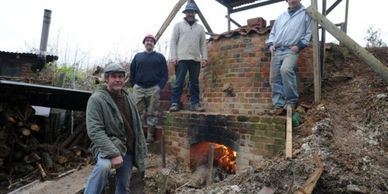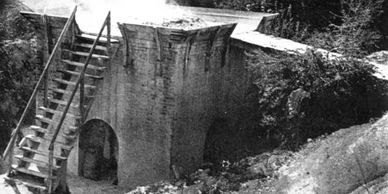GESTINGTHORPE 'THEN & NOW' PHOTOGRAPHIC BOOK - COMING IN 2025 - hopefully!
Our Living Archeology Projects
The Kiln
The Hovel & Bread oven
The Hovel & Bread oven
After years of discussion and over 2 years of construction our Medieval wood fired updraft kiln was fired for the first time. We try to fire this a couple of times a year full of pots, bricks, tiles and anything else that can cope with 1000°C!
the Saxon water mill
The Hovel & Bread oven
the Saxon water mill
Following on from the bread oven, we thought it might be nice to grind the grain to make the flour before we bake the bread. Here is our answer to this (Note: there are no nails used in the structure, every joint was hand cut and pegged - just how the Saxons would have done it).
the wind pump
the Saxon water mill
Pieces of this wind pump have been laying around for a number of years unloved. We have rebuilt it and it now circulates water in Hill Farm's fish pond.
Saxon Hovel & Bread Oven
Coracle Building
an ancient craft
There are a number of ponds within the parish of Gestingthorpe, together with the Belchamp Brook that borders the village to the North. We have a plan in mind to navigate the brook from Gestingthorpe to the Stour at Sudbury (a distance of some 4 miles) in a home made coracle.
building
Thin strips of pliable wood are first cut and the diameter of the coracle established (a similar shape to an egg). Once tacked together and central support plank is added which will act as the seat once we turn the boat the right way up. Ribs of wood are then added from front to back of the boat before opposing strips are added and woven through to strengthen the shape. Once the shape is established it becomes quite strong - cotton calico is then wrapped over the frame before being stapled to the wooden supports. Finally several coats of bitumen paint are needed to seal the calico and make it waterproof.
launching
Balance in a coracle is essential - because of their size, your weight needs to be central or you can easily capsize. A lot of practice has take place on shallow ponds in warm weather (and there have been a few duckings!). Some of the Belchamp Brook has been navigated, but owing to this never having been done before (as far as we know), we still have trees and branches to clear which takes time, watch this space to see if we achieve our goal!!
Coracle Video
The first voyage of our coracle on the pond.
Coracle Making Photo Gallery















The Lime Kiln

WHY BUILD A LIME KILN?
Good question! We have a number of historic projects completed and in the process of construction - we prefer to use traditional methods of construction using handmade bricks, wood or other traditional building techniques. The mortar best suited for traditional brickwork using soft handmade bricks is lime as this is able to breathe and flex somewhat over the course of time, allowing a structure to expand and contract as the seasons change (something modern hard cement does not) - also the use of lime render on wattle and daub walls helps to finish and protect the otherwise delicate surface from the ravages of the weather.

BORN OUT OF NECESSITY
We have a ready supply of clay, wood and sand within the parish of Gestingthorpe and in the adjacent parish of Bulmer we also have a chalk pit, so in order for us to lessen the cost of buying in commercial lime from an external source we decided to build our own lime kiln specifically for burning chalk to create Calcium Oxide.

SMALL BUT PERFECTLY FORMED
Whilst small, our lime kiln works very efficiently - the tall chimney is filled with a mixture of wood and chalk and as the fire burns from below and through the layers of wood and chalk above, the chalk eventually drops down to the bottom where it can be raked out before being plunged in water where the exothermic reaction takes place and the chalk breaks down to a lime putty (as long as this putty is kept with a layer of water on top of it - it will keep indefinitely). Once the putty is exposed to the air it will harden back to Calcium Carbonate.
Our Medieval Brick Kiln
Our wood-fired medieval updraft brick kiln at full temperature!
Here we light the kiln for the first time, June 21st 2013.
Slowly getting up to temperature
Two days later and it is cool enough to open
Top of the chamber before brick removal
Lots of pots and bricks in varying colours
2nd Firing of the Kiln, August 2013
Loading kiln number 3, October 2013
Unloading kiln number 3, October 2013
Unloading kiln number 4, December 2013
Unloading kiln number 5, April 2014
Digging a new batch of clay for 2020



